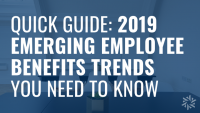Open enrollment is a period of time each year when your current employees can make changes to their existing medical coverage. During open enrollment, employees may decide to change plans, add or drop a dependent or add an optional benefit, such as a dental plan or voluntary life insurance. You can assist employees during open enrollment by distributing materials that explain new health options and changes to existing benefits.
Your company and your employees are likely investing most of your benefit dollars into healthcare, so effective communication is important for everyone to get the most from this high-value benefit. There are many strategies to consider specifically regarding healthcare education at open enrollment.
Open Enrollment Education Strategies
General Summary of Benefits by Plan
Your health care plans will come with the federally mandated Summary of Benefits & Coverage (SBC) and the carrier specific plan documentation, but these can be overwhelming to employees, especially when you offer multiple plans. Help employees navigate the major benefits of each plan by providing an easy-to-read general summary. Austin clients can receive both a Highlight Sheet and Benefit Guide, completely customized based on plan offerings that helps break down plan differences in simple language and visual examples.
Limits on Coverage, especially for specific conditions
While ACA-compliant plans have no maximum limit on coverage, there may be specific limits for certain services. For example, for chiropractic office visits, members may be limited to 30 covered visits in one plan year. Large groups can review their available claims experience data to identify areas that will be of greatest importance for communication to their employees.
Preventive Care Review
The importance of communicating preventive care cannot be stressed enough, year-round, and at Open Enrollment. Make sure your employees receive information on all no-cost preventive services, medications, etc. available for offered plans. Areas of focus can include annual physicals, mental health screening, well-women visits, flu vaccination and more.
Cost-Sharing Details
Does your company offer a premium contribution? Use this to illustrate the value of your benefit package (especially for health care) which can have a large impact on retention. If you offer contributions to an HRA, HSA, or FSA make sure to create communications that discuss how employees can best utilize these funds with your offered plans.
Had to make cuts this year? Make sure your employees are aware of these changes in advance and showcase other money-saving opportunities within your benefits package. Need help with communicating cuts and other benefits changes? Partner with Austin Benefits Group for custom, strategic messaging.
New Plan Types, HDHP, and HSA Information
With change comes confusion, so make it as easy as possible on your employees (and your HR team) by making sure you’re talking about changes in advance and educating employees on how new plan types work. You can check out our All About HSAs presentation and other material on the Benefit Resource Center for ideas!
Terminology Refresher
Offer a review for your team on common benefit terms that are relevant to your plan offerings. A quick glossary can be especially helpful to employees who have not reviewed any benefit information since their last enrollment. A good place to store your glossary year-round is on your company intranet or online benefits or HR system. You could also include a few helpful glossary terms in the bottom of your open enrollment announcement emails. Use the terms below to get started!
Open Enrollment Glossary of Terms – Health Insurance
Coinsurance – The amount or percentage that you pay for certain covered health care services under your health plan. This is typically the amount paid after a deductible is met, and can vary based on the plan design.
Copayment – A flat fee that you pay toward the cost of covered medical services.
Covered Expenses – Health care expenses that are covered under your health plan.
Deductible – A specific dollar amount you pay out of pocket before benefits are available through a health plan. Under some plans, the deductible is waived for certain services.
Dependent – Individuals who meet eligibility requirements under a health plan and are enrolled in the plan as a qualified dependent.
Flexible Spending Account (FSA) – An account that allows you to save tax-free dollars for qualified medical and/or dependent care expenses that are not reimbursed. You determine how much you want to contribute to the FSA at the beginning of the plan year. Most funds must be used by the end of the year, as there is only a limited carryover amount.
Health Maintenance Organization (HMO) – A type of health insurance plan that usually limits coverage to care from doctors who work for or contract within a specified network. Premiums are paid monthly, and a small copay is due for each office visit and hospital stay. HMOs require that you select a primary care physician who is responsible for managing and coordinating all of your health care.
Health Reimbursement Arrangement (HRA) – An employer-owned medical savings account in which the company deposits pre-tax dollars for each of its covered employees. Employees can then use this account as reimbursement for qualified health care expenses.
Health Savings Account (HSA) – An employee-owned medical savings account used to pay for eligible medical expenses. Funds contributed to the account are pre-tax and do not have to be used within a specified time period. HSAs must be coupled with qualified high-deductible health plans (HDHP).
High Deductible Health Plan (HDHP) – A qualified health plan that combines very low monthly premiums in exchange for higher deductibles and out-of-pocket limits. These plans are often coupled with an HSA.
In-network – Health care received from your primary care physician or from a specialist within an outlined list of health care practitioners.
Inpatient – A person who is treated as a registered patient in a hospital or other health care facility.
Medically Necessary (or medical necessity) – Services or supplies provided by a hospital, health care facility or physician that meet the following criteria: (1) are appropriate for the symptoms and diagnosis and/or treatment of the condition, illness, disease or injury; (2) serve to provide diagnosis or direct care and/or treatment of the condition, illness, disease or injury; (3) are in accordance with standards of good medical practice; (4) are not primarily serving as convenience; and (5) are considered the most appropriate care available.
Medicare – An insurance program administered by the federal government to provide health coverage to individuals aged 65 and older, or who have certain disabilities or illnesses.
Member – You and those covered become members when you enroll in a health plan. This includes eligible employees, their dependents, COBRA beneficiaries and surviving spouses.
Out-of-network – Health care you receive without a physician referral, or services received by a non-network service provider. Out-of-network health care and plan payments are subject to deductibles and copayments.
Out-of-pocket Expense – Amount that you must pay toward the cost of health care services. This includes deductibles, copayments and coinsurance.
Out-of-pocket Maximum (OOPM) – The highest out-of-pocket amount paid for covered services during a benefit period.
Preferred Provider Organization (PPO) – A health plan that offers both in-network and out-of-network benefits. Members must choose one of the in-network providers or facilities to receive the highest level of benefits.
Premium – The amount you pay for a health plan in exchange for coverage. Health plans with higher deductibles typically have lower premiums.
Primary Care Physician (PCP) – A doctor that is selected to coordinate treatment under your health plan. This generally includes family practice physicians, general practitioners, internists, pediatricians, etc.
Usual, Customary and Reasonable (UCR) Allowance – The fee paid for covered services that is: (1) a similar amount to the fee charged from a health care provider to the majority of patients for the same procedure; (2) the customary fee paid to providers with similar training and expertise in a similar geographic area, and (3) reasonable in light of any unusual clinical circumstances.
You can download a print-friendly version of this glossary at the end of this post. Looking for even more benefits and HR guidance? Check out our Benefit Resource Center.

Healthcare & Open Enrollment Reminders
Remember these tips when creating and evaluating your open enrollment communication, especially in the complicated realm of health care.
Communicate frequently – but avoid overwhelming employees with information. Give your team ample time to absorb new information, ask questions and express concerns.
Use simple terms to explain changes.
Explain goals and rationale of health care benefit options to managers and business leaders so they can effectively explain health plans to employees.
Be ready to answer questions and face challenges from employees regarding changes.
Provide network and provider information to employees that will be available to them in new or revised plan options.
Provide testimonials from other employees about their experiences with changes in health care coverage.
Use a variety of communication methods, such as the Internet, printed materials and face-to-face discussions.
Don’t forget to contact your dedicated Austin Account Team for help with open enrollment and health care communication. We’re here to make this your best open enrollment ever! Contact us today for a free consultation if you’re ready to revolutionize your benefits.



